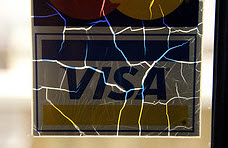Sign The Slip Or Enter Your PIN? The Difference Is Fees
The NYT has an interesting article about what does on behind the scenes when you make a purchase at a retailer with your VISA debit card. You typically have two choices — you can enter your PIN or choose to sign. When you sign the retailer has to pay higher fees to VISA.
This means that depending on which store you’re at, you might be being encouraged to choose one or the other:
At checkout counters, meanwhile, consumers are quietly tugged in one direction or the other.
Safeway, 7-Eleven and CVS drugstores automatically prompt consumers to do a less costly PIN debit transaction. The banks, however, still steer consumers toward the more expensive form of signature debit. Wells Fargo and Chase are among those that offer bonus points only on debit purchases completed with a signature.
Visa says it does not care how consumers use their debit card, as long as it is a Visa. But for now at least, the company says the only way to ensure that a purchase is routed over the Visa network is to sign.
“When you use your Visa card, you have a chance to win a trip to the Olympic Winter Games,” a new Visa commercial promises.
The commercial does not explain the rules, but the fine print on Visa’s Web site does: nearly all Visa purchases are eligible — as long as the cardholder does not enter a PIN.
At IKEA if you use your debit card with a PIN they offer you a coupon worth 3% that you can use the next time you buy something with your debit card. What PIN incentive schemes have you noticed?
How Visa, Using Card Fees, Dominates a Market [NYT]
Want more consumer news? Visit our parent organization, Consumer Reports, for the latest on scams, recalls, and other consumer issues.


